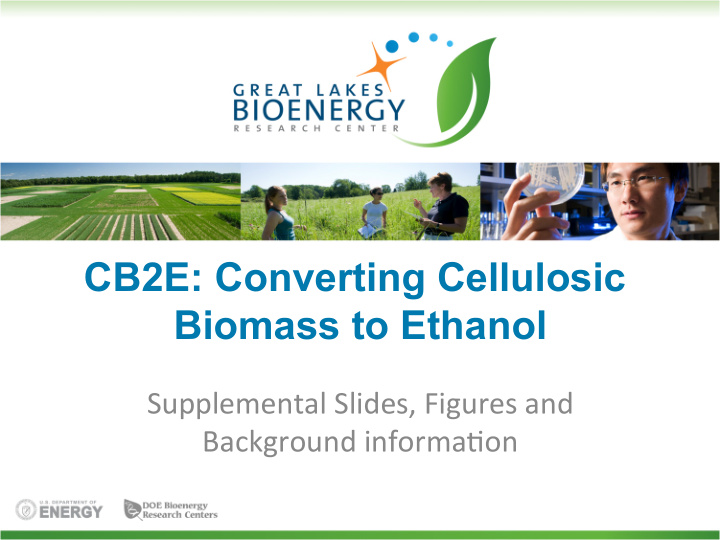



CB2E: Converting Cellulosic Biomass to Ethanol Supplemental ¡Slides, ¡Figures ¡and ¡ Background ¡informa7on ¡
Introduction and Discussion Questions www.glbrc.org ¡
3 ¡ What is ethanol? � Clear ¡liquid ¡ � Chemical ¡formula: ¡C 2 H 6 O ¡ 2-D structure 3-D structure � Burns ¡without ¡smoke ¡ � Some ¡uses: ¡ � Transporta7on ¡fuel ¡ � Alcoholic ¡beverages ¡ � An7sep7cs ¡ � Solvents ¡ www.glbrc.org ¡
4 ¡ How is ethanol made? Fermenta7on ¡of ¡sugars ¡from ¡plants ¡ ¡ Sugars (glucose) + yeast → ethanol + carbon dioxide http://www.dordt.edu/academics/programs/engineering/senior_design/2008/fermentation.shtml www.glbrc.org ¡
Corn Today’s Fuel Corn Ethanol Corn Starch Sugar cane Sugar Cane Heat or enzymes Glucose Glucose Fermentation Fermentation Ethanol Ethanol
What can be used to make 6 ¡ sugars for fermentation? � Sugar ¡ ¡ � Extract ¡sugars ¡directly ¡from ¡plants ¡– ¡very ¡easy ¡ � Starch ¡ � Break ¡the ¡starch ¡down ¡into ¡sugar ¡(glucose) ¡–preNy ¡ easy ¡(you ¡can ¡do ¡this ¡with ¡your ¡saliva) ¡ � Cellulose ¡ � Break ¡the ¡cellulose ¡down ¡into ¡sugar ¡(glucose) ¡– ¡ hard ¡(you ¡can’t ¡do ¡this, ¡but ¡many ¡organisms ¡can) ¡ www.glbrc.org ¡
7 ¡ What can be used to make sugars for fermentation? � Ethanol � Plants � Sugars (glucose) � cellulose � sugar � starch www.glbrc.org ¡
Ethanol Compared to 8 ¡ Gasoline – Pros and Cons Ethanol ¡Pros ¡ Ethanol ¡Cons ¡ � Renewable ¡– ¡made ¡from ¡ � Food ¡vs. ¡Fuel ¡(making ¡ plants! ¡ ethanol ¡from ¡corn) ¡ � Reduc7on ¡in ¡CO 2 ¡ � Difficult ¡to ¡make ¡from ¡ emissions ¡(why?) ¡ other ¡sources ¡(cellulose) ¡ � Cleaner ¡burning ¡ � Gallon ¡of ¡ethanol ¡has ¡2/3 ¡ energy ¡of ¡gallon ¡of ¡ � Domes7cally ¡produced ¡ gasoline ¡ � Cheaper ¡(usually) ¡ � Sufficient ¡land ¡to ¡produce ¡ enough ¡fuel? ¡ www.glbrc.org ¡
Concerns with Corn Ethanol � Annual crop § Dependent on chemical inputs § Soil erosion, water quality problems § Little below ground carbon storage � Food versus fuel � Impacts on biodiversity
What is cellulosic biomass?
What is Cellulosic Biomass?
Sources of cellulose � Corn stalks, leaves, and husks (stover) � Grasses grown as crops � Prairie grasses � Sawdust and woodchips � Yard waste � Any plant!
What is Cellulose?
Plant Cell Wall Structure � Cellulose—primary carbohydrate goal for extraction � Hemicellulose— carbohydrate, harder to convert to fuel � Lignin—may be burned for heat/electricity, converted into useful chemicals
Cellulosic Biofuels � Cellulose is the most abundant biological material on Earth � Found in cell walls � Lack efficient way to break down plant material and convert it into fuel � Cell wall composition varies
!"#$%&&'2//3&,#45&'67%")%8)/'+#0'!"))"#*'9#*-:/%0';%07/&,'"*',</'=>?>' @>A>'B/0)%45C'/,'%)C'DEEFC'!"#$%&&'%&'+//3&,#45'+#0'%'8"#/*/0G.'%*3'8"#H0#3I4,&'"*3I&,0.J'9</',/4<*"4%)'+/%&"8")",.'#+'%'8"))"#*K,#*' %**I%)'&IHH).'(ALM-NLKOEDEEFKDOPF1>'L%5'@"3G/C'9QJ'=?'ALM' '#!" '!!" !"#$%&&'($"))"#*&'#+',#*&-./%01' &#!" &!!" %#!" %!!" $#!" $!!" #!" !"
Background Information and Graphs Energy ¡Use ¡and ¡Poten7al ¡for ¡Biofuels ¡
Energy Information Administration. Annual Energy Review 2008. http://www.eia.doe.gov/emeu/aer/pdf/aer.pdf
C. ¡Cleveland ¡and ¡R. ¡Kaufmann, ¡Fundamental ¡principles ¡of ¡energy, ¡2008, ¡Encyclopedia ¡of ¡Earth ¡
U.S. Energy Sources: Historical
23 ¡ 67*5+8#9*713:*1#;8#<.0/=*# >0*?*0,7@A#>"#B"#,7@#C"#D,/E=,77A#&!!FA#G/7@,=*74,0#H537I3J0*1#.E#67*5+8A#67I8I0.J*@3,#.E#6,54K# KLJM22NNN"*.*,54K".5+2,5:I0*2G/7@,=*74,0OJ537I3J0*1O.EO*7*5+8## ($"!# (!"!# '$"!# '!"!# )*+,-./0*12034*5# &$"!# &!"!# %$"!# %!"!# $"!# !"!# www.glbrc.org ¡
24 ¡ www.glbrc.org ¡
What is the Great Lakes Bioenergy Research Center (GLBRC)?
26 ¡ The Mission of GLBRC � To perform the basic research that generates technology to convert cellulosic biomass to sustainable biofuels . www.glbrc.org ¡
GLBRC: 1 of 3 DOE Bioenergy Research Centers
28 ¡ GLBRC Research Roadmap ¡Four ¡discovery ¡science ¡areas ¡provide ¡knowledge ¡to ¡sustainably ¡convert ¡ cellulosic ¡biomass ¡into ¡liquid ¡transporta7on ¡fuels ¡ www.glbrc.org ¡
GLBRC: Who We Are ~400 scientists, staff & students across sites � 70 Faculty (17%) � 29 Senior scientists (7%) � 66 Post-doctoral scientists (16%) � 52 Ph.D. Students (13%) � 55 Technicians (14%) � 85 Undergraduates (23%) � 42 Support staff in Operations, IIT, E&O (10%) � ~ 60 Research Projects
Process for Making Cellulosic Ethanol Overview ¡
Moving Beyond Corn Ethanol ¡ Tomorrow ’ s technology (GLBRC) Plant biomass ? Pretreat (grind, heat, cellulosic material chemicals, pressure) Today ’ s ¡technology ¡ “ Loosened ” cell wall material Corn ¡ ¡ (kernels) ¡ (cellulose hemicellulose, lignin) Starch ¡ ? Enzymes (cellulases, etc) or microbes Heat and/or Sugar ¡ ¡ enzymes Mixed sugars, etc. Cane ¡ ( glucose, arabinose, xylose, Glucose ¡ Glucose ¡ phenolics, etc.) ? Fermentation Fermentation Fermentation (microbes) (microbes) (microbes) or catalysts Ethanol ¡(next ¡genera7on ¡fuel) ¡ Ethanol ¡ Ethanol ¡
How Cellulosic Ethanol is Made
Step 1: Pretreatment Goal: ¡use ¡heat, ¡grinding ¡to ¡break ¡ down ¡plant ¡cell ¡walls ¡to ¡release ¡ cellulose ¡fibers ¡
Effect of Pretreatment of Corn Cob Granule Sclereid Cells
Step 2: Enzyme Digestion (Hydrolysis) Goal: ¡use ¡cellulase ¡enzymes ¡to ¡break ¡ down ¡cellulose ¡fibers ¡into ¡glucose ¡ molecules ¡(sugar) ¡
Enzyme Digestion (Hydrolysis) � Cellulose must be broken into individual glucose molecules using enzymes before fermentation can occur. cellulose enzyme glucose glucose glucose glucose
Endocellulase in Action! Long ¡PT-‑rich ¡linker ¡ GH5 ¡Cataly7c ¡domain ¡ CBM2 ¡carbohydrate ¡ binding ¡domain ¡ Cellulose ¡
Catalytic Domain Pulling up Cellulose Strand
Hydrolysis and Release of Catalytic Subunit
Step 3: Fermentation Goal: ¡use ¡yeast ¡to ¡consume ¡glucose ¡ and ¡produce ¡ethanol ¡(fuel) ¡
Standard fermentation: • enzymes in yeast convert glucose into ethanol and carbon dioxide when there is no oxygen. yeast glucose 2 ethanol 2 carbon dioxide CO 2 ethanol
Recommend
More recommend